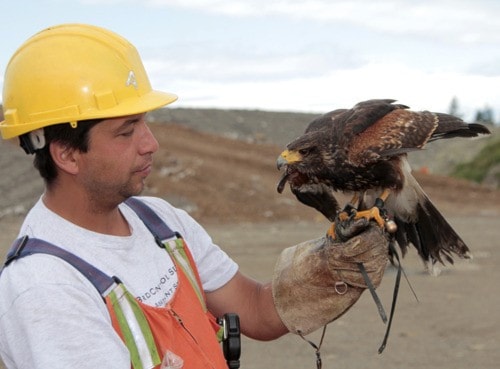There’s no free lunch, not even for seagulls hanging out at the local landfill.
The Regional District of Nanaimo’s landfill on Cedar Road has given seagulls, crows and other birds that pick garbage the bum’s rush since it started using raptors to control birds in 1991.
Birds feeding from landfills pose health and safety hazards for landfill employees, as well as residents and workers on neighbouring properties.
The RDN landfill was among the first in B.C. to use raptors to control unwanted birds.
At the time, some landfills used noise cannons to frighten off flocks or strung monofilament wire, similar to heavy fishing line, above the sites to foil birds’ attempts to land. Birds often became ensnared in the wire and had to be killed.
Many landfills still use noise cannons, but with private properties in close proximity around the RDN facility, loud bangs would upset the neighbours plus indiscriminately frightening birds off the site creates an unacceptable health and safety risk.
Raptors are quiet, environmentally safe and can clear the landfill’s open working faces, while enabling birds to settle within landfill property boundaries.
“If we didn’t have the raptors, those gulls and their droppings would be all over that equipment and our workers wouldn’t be able to see,” said McIver.
Hawks kill and eat gulls, so every gull knows it risks death flying onto the working faces of the landfill where Kevin Letts, owner of P.K. Bird Control Services, works his hawks.
Letts has eight birds and rotates them through to keep them exercised.
“They all fly hard,” Letts said.
Having multiple birds means if one hawk is injured, sick or simply flies off and fails to return, another can take its place. Most working birds are one to 10 years old.
Belle, a 21-year-old red tail hawk, is his oldest bird, which Letts said is likely the oldest bird working landfills in B.C.
Belle’s years of experience have taught her not to be in too big a hurry to fly out and kill something, because she knows Letts will reward her with chunks of chicken and rabbit when he holds his arm out as a perch.
She’s also calm around people and will even let strangers pet her, but the results of her work serve as powerful warnings to scavengers.
“We’ll leave a kill on the ground for a few hours so the other birds can see it,” Letts said.
As the RDN landfill has been transformed into a sophisticated solid waste management site that now captures landfill gas to produce electrical power, the role of the raptor program is shifting.
In 2010 an old portion of the landfill that was in danger of leaking rainwater needed upgrading. The fix required raising the level of fill to increase the slope angle so rainwater could run off more easily and then put a new weather cap on the site.
McIver said the work triggered her worst nightmare in November when it displaced the gulls that normally loafed on that portion of the landfill and they repositioned themselves by the hundreds on nearby roofs.
Staff called in a seagull expert for advice and at the same time decided to allow the birds to choose another roosting site within landfill property. That solved the immediate problem, but the birds could be displaced again when the regional district permanently closes the six-hectare section to create a public nature park, which is scheduled to open in the summer of 2013.
Combining the use of raptors with new landscape design features and fully diverting food and other organic waste from the landfill should solve the gull problem.
“Before we get to the actual park construction next year, we don’t want those seagulls coming back and roosting there because the nature park can’t be a place for seagulls,” McIver said. “So, in the detailed design of the nature park, we’re being informed by our expert on seagulls as to how we should landscape it, how we should design it, so that we’re not encouraging the birds to come and stay there. We’ve learned a lot about seagulls.”
